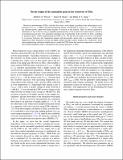Files in this item
On the origin of the anomalous peak in the resistivity of TiSe2
Item metadata
| dc.contributor.author | Watson, Matthew David | |
| dc.contributor.author | Beales, Adam M. | |
| dc.contributor.author | King, Philip David | |
| dc.date.accessioned | 2019-05-09T10:30:02Z | |
| dc.date.available | 2019-05-09T10:30:02Z | |
| dc.date.issued | 2019-05-23 | |
| dc.identifier | 258894657 | |
| dc.identifier | bfd89487-079c-4cd9-8bc2-fd542450199d | |
| dc.identifier | 85066403730 | |
| dc.identifier | 000469061700003 | |
| dc.identifier.citation | Watson , M D , Beales , A M & King , P D 2019 , ' On the origin of the anomalous peak in the resistivity of TiSe 2 ' , Physical Review. B, Condensed matter and materials physics , vol. 99 , no. 19 , 195142 . https://doi.org/10.1103/PhysRevB.99.195142 | en |
| dc.identifier.issn | 1098-0121 | |
| dc.identifier.other | ORCID: /0000-0002-0737-2814/work/58531651 | |
| dc.identifier.uri | https://hdl.handle.net/10023/17676 | |
| dc.description | We gratefully acknowledge support from The Leverhulme Trust (Grant No. RL-2016-006) and The Royal Society. | en |
| dc.description.abstract | Resistivity measurements of TiSe2 typically show only a weak change in gradient at the charge density wavetransition at TCDW ≈ 200 K, but more prominently feature a broad peak at a lower Tpeak ∼165 K, which has remained poorly understood despite decades of research on the material. Here we present quantitative simulations of the resistivity using a simplified parametrization of the normal state band structure, based on recent photoemission data. Our simulations reproduce the overall profile of the resistivity of TiSe2, including its prominent peak, without implementing the CDW at all. We find that the peak in resistivity corresponds to a crossover between a low temperature regime with electron-like carriers only, to a regime around room temperature where thermally activated and highly mobile hole-like carriers dominate the conductivity. Even when implementing substantial modifications to model the CDW below the transition temperature, we find that these thermal population effects still dominate the transport properties of TiSe2. | |
| dc.format.extent | 9 | |
| dc.format.extent | 1044758 | |
| dc.language.iso | eng | |
| dc.relation.ispartof | Physical Review. B, Condensed matter and materials physics | en |
| dc.subject | QC Physics | en |
| dc.subject | TK Electrical engineering. Electronics Nuclear engineering | en |
| dc.subject | DAS | en |
| dc.subject.lcc | QC | en |
| dc.subject.lcc | TK | en |
| dc.title | On the origin of the anomalous peak in the resistivity of TiSe2 | en |
| dc.type | Journal article | en |
| dc.contributor.sponsor | The Royal Society | en |
| dc.contributor.sponsor | The Leverhulme Trust | en |
| dc.contributor.institution | University of St Andrews. Centre for Designer Quantum Materials | en |
| dc.contributor.institution | University of St Andrews. School of Physics and Astronomy | en |
| dc.contributor.institution | University of St Andrews. Condensed Matter Physics | en |
| dc.identifier.doi | 10.1103/PhysRevB.99.195142 | |
| dc.description.status | Peer reviewed | en |
| dc.identifier.grantnumber | URF/R/180026 | en |
| dc.identifier.grantnumber | 2016-006 | en |
This item appears in the following Collection(s)
Items in the St Andrews Research Repository are protected by copyright, with all rights reserved, unless otherwise indicated.

